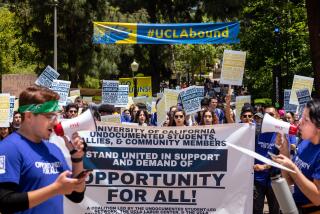Finding Teachers Among Immigrants
As state officials grapple with a chronic teacher shortage and Latino parents demand more Spanish-speaking educators, a privately funded effort is quietly carving into both issues.
The $3.2-million Alianza project, launched this month at Cal State Long Beach, will train immigrants who were teachers in Latin America and want to teach in the United States.
Educators hope that the program will help fill the teacher shortage in Southern California, home to about 2,000 immigrants who had taught in their native countries. By year’s end, the program also will be in place at Arizona State University, the University of Texas-Pan American, the University of Texas at San Antonio and Southwest Texas University.
Former teachers now working as janitors, gardeners and housekeepers are wasting an opportunity to “bring valuable classroom experience to this country,” said Armando Vazquez Ramos, a Chicano Studies professor at Cal State Fullerton who helped create Alianza.
Program sponsors say immigrant educators can narrow the cultural gap between students and teachers at predominantly Latino schools that have a shortage of state-certified Latino educators.
In the Los Angeles Unified School District, for example, about 69% of 697,000 students are Latino, compared with 24% of the teachers. With enrollment growth expected to require at least 4,500 new teachers every year, Los Angeles city school officials also hope Alianza will reduce that discrepancy.
Statewide, Latinos are expected to make up half of the public school students in kindergarten through 12th grade by 2008. Latino instructors now comprise 12% of California teachers.
“The importance of this program is one of providing students with a teaching force that is diverse,” said Los Angeles school board President Victoria Castro.
Immigrant Latino students and parents need teachers who can understand their ethnic backgrounds and serve as role models, she said.
Frustration over the shortage of Latino teachers in Los Angeles public schools erupted this month at Burton Street Elementary School in Panorama City, where the principal was reportedly attacked for being white.
Burton Street School parent Socorro Patino denounced the attack, but said many students and parents at the mostly Latino school feel alienated by the mostly white staff.
“They don’t understand how we feel, the way we expect so much from our teachers,” she said. “They cannot communicate with our children if they have a problem.”
Such sentiments are “a microcosm of what is happening all over,” said Vazquez, who teaches educational reforms that address the needs of the growing Latino population.
“There is an alienation taking place because [non-Spanish-speaking] teachers don’t know how to cope with the changing demographics of their schools,” he said.
Alianza seeks a remedy with immigrant teachers, once the hope of their own homeland. Many left their countries because of civil war, poverty or ambition; they found that, without state certification, they cannot continue in their profession.
“It’s hard to see another teacher in the classroom while I am outside cleaning the hallways,” said Felipe Mejia, a custodian at Roosevelt High School in Boyle Heights. He taught in El Salvador for eight years before moving to Los Angeles in 1989.
“In my country I had an important position,” he said. “Here, there are times when I feel insufficient.”
Mejia and 200 other immigrants accepted into the program will complete a series of classes over five years toward a bachelor’s degrees in education. Required courses include English conversation, U.S. history and child psychology.
Alianza is sponsored by the Washington, D.C.-based Mexican and American Solidarity Foundation and the Intercultural Research Development Assn., a nonprofit organization in San Antonio that develops education programs around the world.
The curriculum is based on a pilot program developed by Vazquez at Cal State Long Beach during the early 1990s.
The pilot program graduated 27 students, all from Mexico, before ending in 1994. More than half of the graduates are now teaching in California and nearby states. Some are pursuing a master’s degree in education, Vazquez said.
The Los Angeles district hired a handful of the graduates, including Judith Colmenares, who emigrated from Oaxaca. She teaches kindergarten at Hoover Elementary School.
“It is not just with language that we can connect with them,” she said. “There’s a whole world of perspective we can share.”
For example, Colmenares said, a non-Latino teacher may ask parents to keep a struggling student in his bedroom, away from the TV, until he finishes his homework.
They may not understand, she said, that some students “live with their whole families inside one room. . . . We can work with the parents on different solutions because we understand their situation.”
One reason, she said, is experience. Colmenares had worked as the only teacher at a village school in Mexico, serving a class of children spanning six grades. After moving to Los Angeles, she became a supermarket cashier, studying late at night and volunteering as a teachers assistant.
For parents and students in similar struggles, she said, “Who can be a better role model than someone who has gone through the same experiences? Many of us have been there before.”
Skeptics say they are most concerned about the thorny issue of language. Unlike Arizona and Texas, which are seeking to train more bilingual teachers, California under Proposition 227 requires an English-only curriculum.
Immigrant teachers still grappling with English may not have the fluency to work effectively with children or colleagues, said Gloria Matta Tuchman, an elementary school teacher in Santa Ana and the coauthor of Proposition 227.
Non-Spanish-speaking students could become frustrated by heavy accents, she said, and “tune out.”
One Los Angeles principal said a Mexican teacher she hired from the Cal State Long Beach pilot program is doing poorly.
Though the teacher has years of experience in Mexico, “his lack of English is desperately sad,” said the principal, who requested anonymity.
“He’s trying, but the fluidity of instruction is not there,” the principal said. “You have to also be able to collaborate with your peers and problem-solve” in English.
Alianza supporters dismiss such concerns, contending that teachers must pass English reading and writing exams before earning state credentials. Also, the Alianza students fall under a new Cal State Long Beach policy that guarantees one-on-one assistance for any of its teachers who have trouble during their first year in the classroom.
Such worries are remote to the 20 teachers enrolled in Alianza’s first class. Several work more than 40 hours per week, tethered to such low-paying jobs as janitor, gardener, housekeeper and cashier. They see their new weekend classes as the road to prosperity.
“I’m on my way,” said Martin Guevara. He went from being a popular elementary school teacher in El Salvador--using props and comedy in his lessons--to a string of low-wage jobs at restaurants, hotels and hospitals in the United States over the past eight years.
Guevara, 29, said he was embarrassed when his 5-year-old daughter boasted to her kindergarten teacher about his classroom experience. “I felt so frustrated when I heard her say: ‘My daddy is a teacher too!’ ” Guevara said.
One day, while playing soccer in Burbank, Guevara heard his past calling to him across the field: Maestro!
It was a former fourth-grade student, now a man, who recognized Guevara sprinting across the field. On one hand, he said, “I was so happy to see that he had a life over here too.”
Then Guevara found out his former student earned more money than he did and he flushed with shame over not being a teacher.
Maria Escobar, once a grade school teacher and principal in Mexicali, sees Alianza as a balm against poor self-esteem for immigrant teachers and for Latino students.
Escobar is raising two daughters on the money she makes as a stocker and cashier at Costco. Her older child is in college, she said proudly.
“Before, people could only picture us Mexican immigrants sitting under a cactus with our heads down,” Escobar said.
Now, she said, “We are in a position to prove that we have a lot to offer. And not just to the Spanish-speaking students. The Chicanos, who don’t know about their own culture. We can help them appreciate where their parents came from.”
More to Read
Sign up for Essential California
The most important California stories and recommendations in your inbox every morning.
You may occasionally receive promotional content from the Los Angeles Times.










